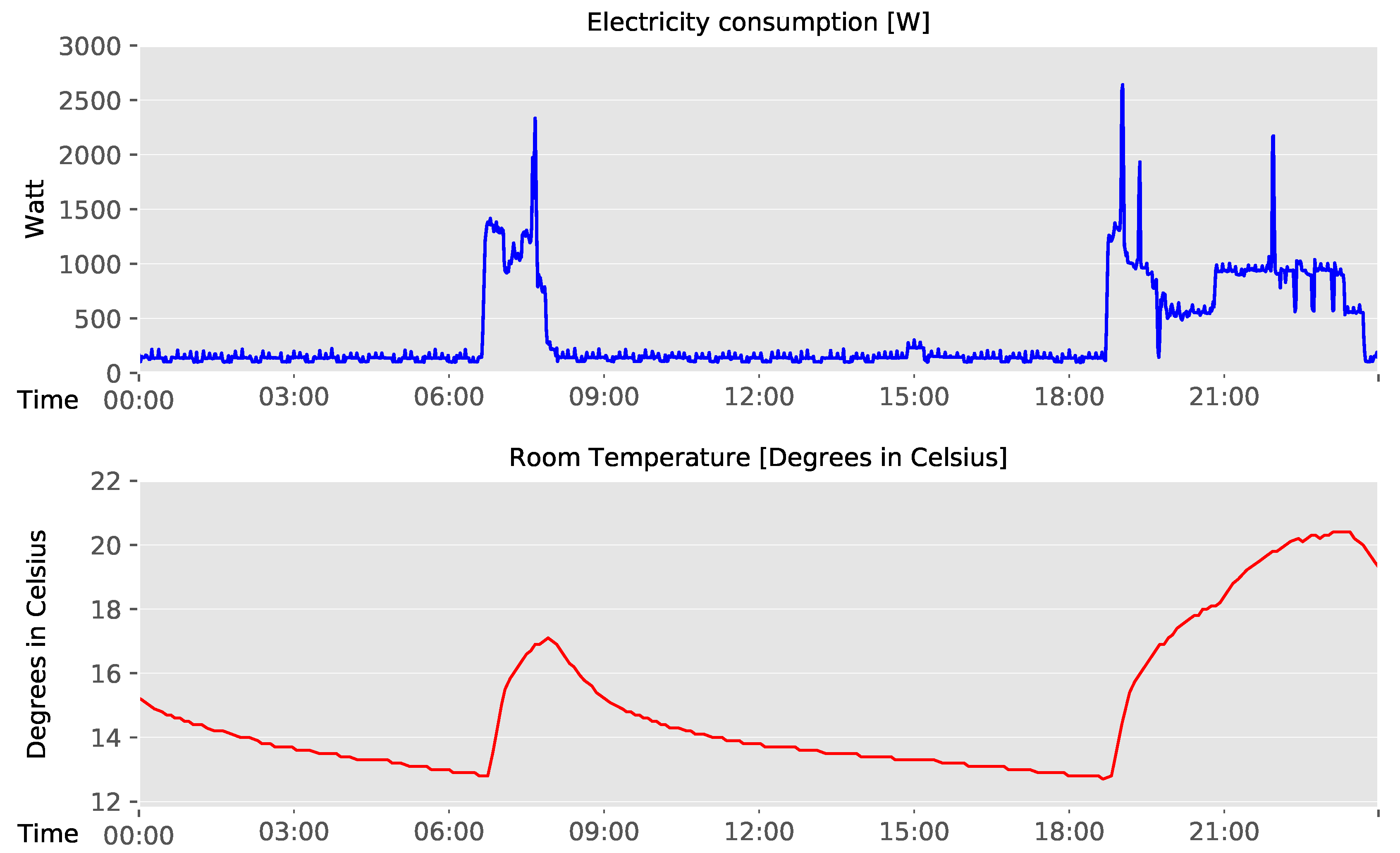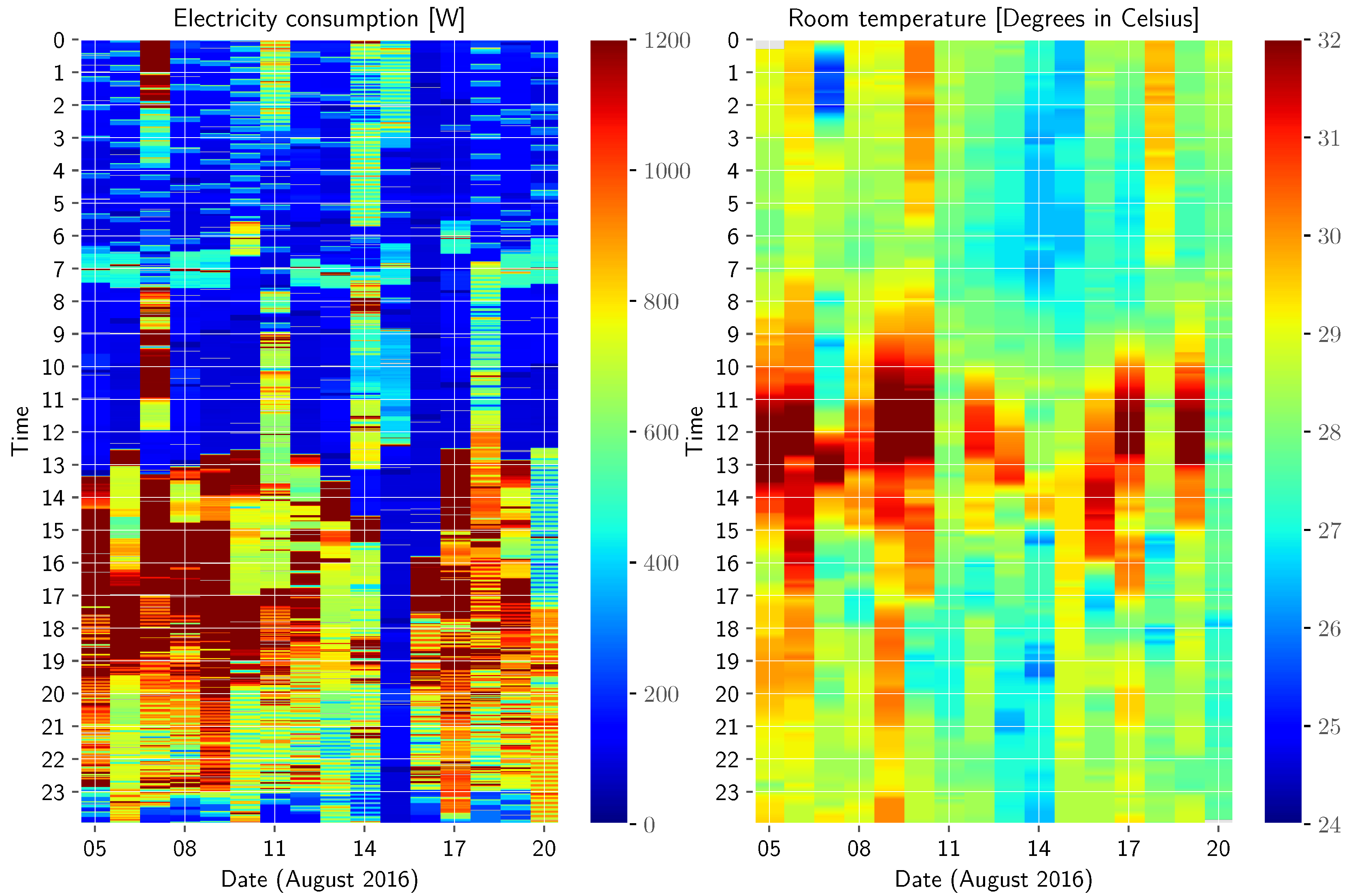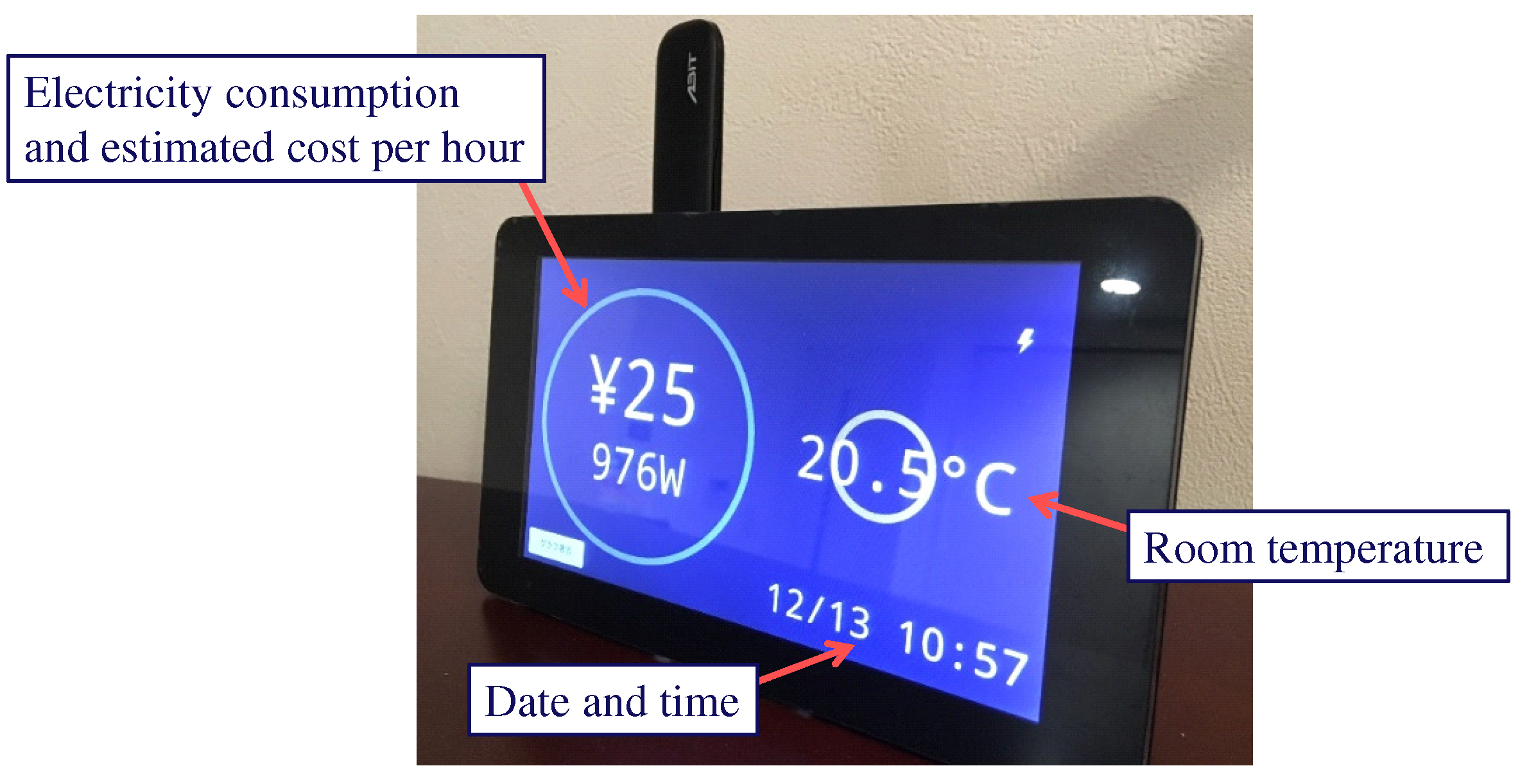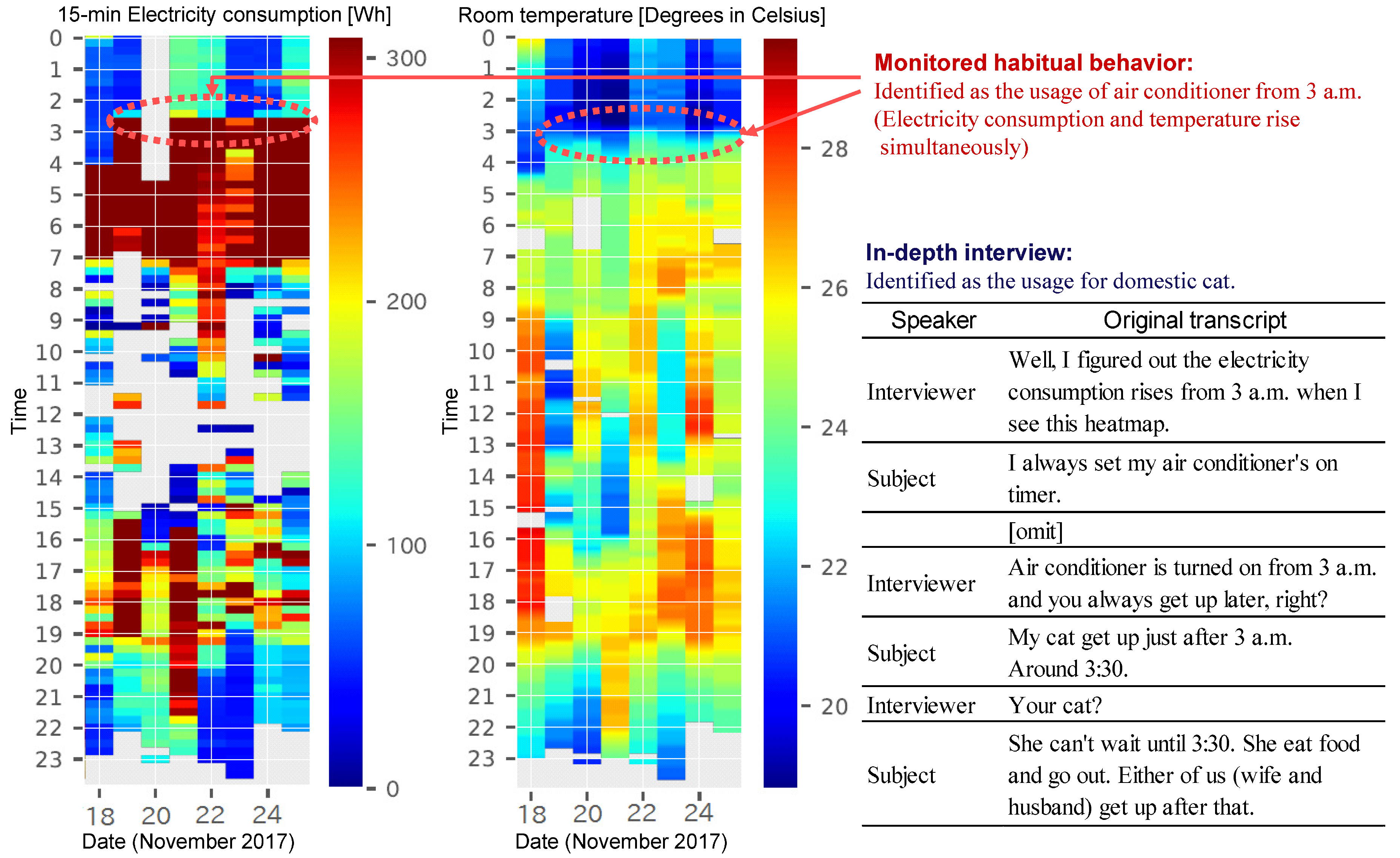In-Home Behavioral Observation Method Employing Internet of Things Sensors for Barrier Investigation of Energy Saving Activities †
Abstract
:1. Introduction
2. Related Work
2.1. Information Provision for Energy Saving
- Detailed feedback (personalized or appliance level feedback)
- Direct feedback (provided in real-time)
2.2. Behavioral Observation
2.3. In-home Sensing with IoT Sensors and Smart Meters
3. In-Home Behavioral Observation Method Employing IoT Sensors
3.1. In-home Sensing with IoT Sensors
- The capacity for in-home sensing for extended periods.
- The ability to monitor the necessary and sufficient activities at a low cost.
3.2. Visualization of Sensor Data
- The ability to grasp the general activities of daily living.
- The ability to grasp the usage of home appliances related to in-home activities.
- The ability to grasp habitual behaviors and their changes.
- Getting up at approximately 6 a.m. and going out at approximately 7:30.
- Air conditioning is usually turned off in the morning because electricity consumption is small and temperature changes slowly.
- The room is occupied every few days from 8 to 12 a.m. and air conditioning is used when it is occupied.
- Air conditioning is usually used after coming home around 1 p.m.
- Usually going to bed around 11 p.m.
- Small and short-term rise in electricity consumption is sequentially iterated from 0 to 6 a.m.
- Electricity consumption during midnight occasionally remains high and room temperature remains low (e.g., 7 August).
3.3. In-depth Interview
4. Experiments
4.1. Outline of Experiments
- After specifying the objective of the study and the duration of the interview, the subject signed an agreement form if he/she agrees with the scope of the study.
- The interviewer then received several assignments consisting of drawing their household layout, listing their owned appliances and then questioning about them.
- Subjects were then asked to fill out the check sheet regarding energy saving activities and answer questions about their regular energy saving activities.
4.2. Investigation of Barriers regarding Energy Saving Activities
4.3. Discussion
5. Conclusions
Author Contributions
Funding
Acknowledgments
References
- Allcott, H. Social norms and energy conservation. J. Public Econ. 2011, 95, 1082–1095. [Google Scholar] [CrossRef]
- Komatsu, H.; Nishio, K. An experimental study on motivational change for electricity conservation by normative messages Appl. Energy 2015, 158, 35–43. [Google Scholar] [CrossRef]
- Ehrhardt-Martinez, K.K.; Donnelly, A.; Laitner, S.; Advanced metering initiatives and residential feedback programs: A meta-review for household electricity-saving opportunities. American Council for an Energy-Efficient Economy. 2010. Available online: https://www.smartgrid.gov/files/ami_initiatives_aceee.pdf (accessed on 5 November 2019).
- Armel, K.C.; Gupta, A.; Shrimali, G.; Albert, A. Is disaggregation the holy grail of energy efficiency? The case of electricity. Energy Policy 2010, 52, 213–234. [Google Scholar] [CrossRef]
- Niemeyer, S. Consumer voices: Adoption of residential energy-efficient practices. Int. J. Consum. Stud. 2010, 34, 140–145. [Google Scholar] [CrossRef]
- Beillan, V.; Battaglini, E.; Goater, A.; Huber, A.; Mayer, I.; Barriers and drivers to energy-efficient renovation in the residential sector: Empirical findings from five European countries. ECEEE Report. 2011. Available online: https://www.eceee.org/library/conference_proceedings/eceee_Summer_Studies/2011/5-saving-\energy-in-buildings-the-time-to-act-is-now/barriers-and-drivers-to-energy-efficient-renovation-in-the-\residential-sector-empirical-findings-from-five-european-countries/ (accessed on 5 November 2019).
- Tuominen, P.; Klobut, K.; Tolman, A.; Adjei, A.; Best-Waldhober, M. Energy savings potential in buildings and overcoming market barriers in member states of the European Union. Energy Build. 2012, 51, 48–55. [Google Scholar] [CrossRef]
- Tokyo Metropolitan Government. Survey on Barriers Regarding Energy Saving Activities in Residential Sector; written in Japanese. 2015. Available online: https://www.tokyo-co2down.jp/action/behavioral_inhibition/ (accessed on 5 November 2019).
- Hartmann, D.P.; Barrios, B.A.; Wood, D.D. Principles of behavioral observation. Compr. Handb. Psychol. Assess. 2003, 3, 108–127. [Google Scholar]
- Brown, T. Change by Design: How Design Thinking Transforms Organizations and Inspires Innovation; HarperBusiness: New York, NY, USA, 2009; ISBN 978-0061766084. [Google Scholar]
- Abras, C.; Maloney-Krichmar, D.; Preece, J. User-centered design. In Bainbridge W. Encyclopedia of Human-Computer Interaction; Sage Publications: Thousand Oaks, CA, USA, 2004; Volume 37. [Google Scholar]
- Katz-Buonincontro, J.; Anderson, R.C. How do we get from good to great? The need for better observation studies of creativity in education. Front. Psychol. 2018, 9, 39–48. [Google Scholar] [CrossRef] [PubMed]
- Meyer, A.A.; Lederman, N.G. Inventing creativity: An exploration of the pedagogy of ingenuity in science classrooms. Sch. Sci. Math. 2013, 113, 400–409. [Google Scholar] [CrossRef]
- Eysenbach, G.; Köhler, C. How do consumers search for and appraise health information on the world wide web? Qualitative study using focus groups, usability tests, and in-depth interviews. BMJ 2002, 324, 573–577. [Google Scholar] [CrossRef] [PubMed]
- Geertz, C. Thick description: Toward an interpretive theory of culture. In The Cultural Geography Reader; Routledge: Abingdon, UK, 1973; pp. 41–51. [Google Scholar]
- Singler, E.; Waintrop, F.; Bordenave, R.; Bressoud, E.; French Government: Nudge Me Tender: How to Turn Ethnographic Insight Into More Efficient Policy-Making. ESOMAR Congress. 2014. Available online: https://www.warc.com/content/paywall/article/french_government_nudge_me_tender__how_to_turn_ethnographic_insight_into_more_efficient_policymaking/102656 (accessed on 5 November 2019).
- Thaler, R.H.; Sunstein, C.R. Nudge: Improving Decisions About Health, Wealth, and Happiness; Yale University Press: New Haven, CT, USA, 2008; ISBN 978-0-14-311526-7. [Google Scholar]
- Rashidi, P.; Mihailidis, A. A survey on ambient-assisted living tools for older adults. IEEE J. Biomed. Health Inform. 2013, 17, 579–590. [Google Scholar] [CrossRef] [PubMed]
- Dey, N.; Ashour, A.S.; Shi, F.; Fong, S.J.; Sherratt, R.S. Developing residential wireless sensor networks for ECG healthcare monitoring. IEEE Trans. Consum. Electron. 2017, 63, 442–449. [Google Scholar] [CrossRef]
- Krupitzer, C.; Sztyler, T.; Edinger, J.; Breitbach, M.; Stuckenschmidt, H.; Becker, C. Hips do lie! A position-aware mobile fall detection system. In Proceedings of the IEEE International Conference on Pervasive Computing and Communications, Athens, Greece, 19–23 March 2018; pp. 1–10. [Google Scholar] [CrossRef]
- George, G.; Ihle, H.; Miura, W.; Electricity Market Reform in Japan. Public Utilities Fortnightly. pp. 18–25. 2016. Available online: https://www.nera.com/content/dam/nera/publications/2016/PUF_Article_1_2016.08.pdf (accessed on 5 November 2019).
- Nomura, K.; Kashiwagi, T.; Yamashita, T.; Kawade, T. Solution to utilization of smart meter data. Fujitsu Sci. Tech. J. 2014, 50, 58–66. Available online: https://www.fujitsu.com/global/documents/about/resources/\publications/fstj/archives/vol50-2/paper07.pdf (accessed on 5 November 2019).
- Molina-Markham, A.; Shenoy, P.; Fu, K.; Cecchet, E.; Irwin, D. Private memoirs of a smart meter. In Proceedings of the 2nd ACM Workshop on Embedded Sensing Systems for Energy-efficiency in Buildings, Zurich, Switzerland, 2 November 2010; pp. 61–66. [Google Scholar] [CrossRef]
- Kleiminger, W.; Beckel, C.; Santini, S. Household occupancy monitoring using electricity meters, In Proceedings of the 2015 ACM International Joint Conference on Pervasive and Ubiquitous Computing, Osaka, Japan, 7–11 September 2015; pp. 975–986. [Google Scholar] [CrossRef]
- Hattori, S.; Shinohara, Y. Actual consumption estimation algorithm for occupancy detection using low resolution smart meter data. In Proceedings of the 6th International Conference on Sensor Networks, Porto, Portugal, 9–11 February 2017; pp. 39–48. [Google Scholar] [CrossRef]
- Zoha, A.; Gluhak, A.; Imran, M. A.; Rajasegarar, S. Non-intrusive load monitoring approaches for disaggregated energy sensing: A survey. Sensors 2012, 12, 16838–16866. [Google Scholar] [CrossRef] [PubMed]
- Froehlich, J.; Larson, E.; Gupta, S.; Cohn, G.; Reynolds, M.; Patel, S. Disaggregated end-use energy sensing for the smart grid. IEEE Pervasive Comput. 2011, 10, 28–39. [Google Scholar] [CrossRef]
- Batra, N.; Kelly, J.; Parson, O.; Dutta, H.; Knottenbelt, W.; Rogers, A.; Singh, A.; Srivastava, M. NILMTK: An open source toolkit for non-intrusive load monitoring. In Proceedings of the 5th International Conference on Future Energy Systems, Cambridge, UK, 11–13 June 2014; pp. 265–276. [Google Scholar] [CrossRef]
- Kurz, T.; Gardner, B.; Verplanken, B.; Abraham, C. Habitual behaviors or patterns of practice? Explaining and changing repetitive climate-relevant actions. Wiley Interdiscip. Rev. Clim. Chang. 2015, 6, 113–128. [Google Scholar] [CrossRef]
- Urban, G.L.; Von Hippel, E. Lead user analyses for the development of new industrial products. Manag. Sci. 1988, 34, 569–582. [Google Scholar] [CrossRef]




| Observation by human observer (Existing Method) | Observation by IoT sensor (Proposed method) | |
| Monitoring: Expensive (employ an observer) | Monitoring: Low-cost (use IoT sensors) |
| Analysis: By humans (depend on observer's skill) | Analysis: Visualization (easily automated) | |
| Interview: Depend on observer's skill | Interview: Conduct efficiently with prepared questions based on visualized sensor data | |
| Privacy: Big impact (perceptual information) | Privacy: Small impact (sensor data) |
| Behavior: Big impact (monitored by observer) | Behavior: Small impact (monitored by sensors) | |
|
|
|
| Category | Detail | Mention in interviews (Example of activities) |
| Category 1: Saving money | Consider that an action do not lead to saving | Worry about friction and wear of on-off switch (Keep the lights on even while unoccupued) |
| Category 2: Food preservation | Can't take energy saving actions for food preservation | Worry about food rotting (Cram all kinds of food in fridge) |
| Category 3: Air conditioning given his/her physical state | Adjust room temperature not for saving but for occupant's state | Can't stand the cold (Raise the temperature on air conditioner / electric heater) |
| Category 4: Layout of appliances and furniture | Layout of appliances and furniture prevents from taking actions | Appliance or its plug is out of reach (Don't unplug appliances) |
| Category 5: Habitual behavior and attitude | Can't take actions departing from habitual behavior | Forget to take actions (Don't unplug appliances) |
| Category 6: Family and pet animals | Can't take actions because of the consideration for family and pets | Use air conditoner for my cat (Use air conditioner for a long time) |
| Category 7: Functionality of appliances | Functionality of appliances prevents from taking actions | For record a TV program (Keep main power supply of appliances) |
| Category 8: Information from others | Regard an action as unnecessary based on information from others | I heared we don't have to switch off appliances (Keep main power supply of appliances) |
| Category 9: Security and safety | Can't take actions for keeping occupant's home safe | Afraid of the dark (Keep the lights on even while unoccupued) |
| Category 10: Convenience | Can't take actions for removing the burden of appliance operation | Too much work to do it every time (Don't unplug appliances) |
Publisher’s Note: MDPI stays neutral with regard to jurisdictional claims in published maps and institutional affiliations. |
© 2019 by the authors. Licensee MDPI, Basel, Switzerland. This article is an open access article distributed under the terms and conditions of the Creative Commons Attribution (CC BY) license (https://creativecommons.org/licenses/by/4.0/).
Share and Cite
Hattori, S.; Miura, T.; Ichikawa, R.; Sawai, D. In-Home Behavioral Observation Method Employing Internet of Things Sensors for Barrier Investigation of Energy Saving Activities. Proceedings 2019, 31, 31. https://doi.org/10.3390/proceedings2019031031
Hattori S, Miura T, Ichikawa R, Sawai D. In-Home Behavioral Observation Method Employing Internet of Things Sensors for Barrier Investigation of Energy Saving Activities. Proceedings. 2019; 31(1):31. https://doi.org/10.3390/proceedings2019031031
Chicago/Turabian StyleHattori, Shunichi, Teruhisa Miura, Reiko Ichikawa, and Daiki Sawai. 2019. "In-Home Behavioral Observation Method Employing Internet of Things Sensors for Barrier Investigation of Energy Saving Activities" Proceedings 31, no. 1: 31. https://doi.org/10.3390/proceedings2019031031
APA StyleHattori, S., Miura, T., Ichikawa, R., & Sawai, D. (2019). In-Home Behavioral Observation Method Employing Internet of Things Sensors for Barrier Investigation of Energy Saving Activities. Proceedings, 31(1), 31. https://doi.org/10.3390/proceedings2019031031




